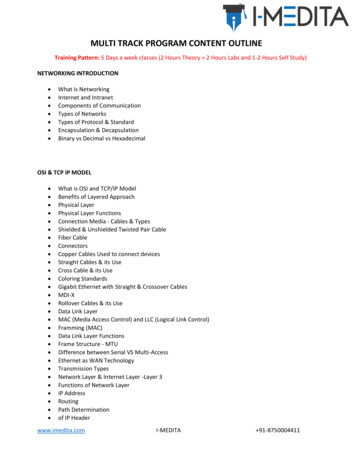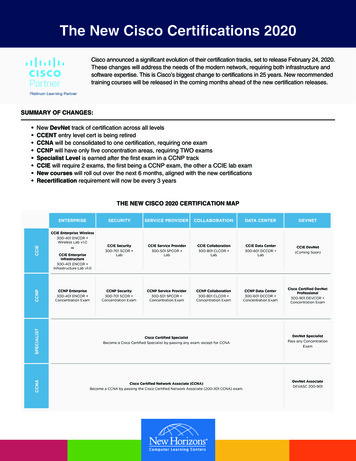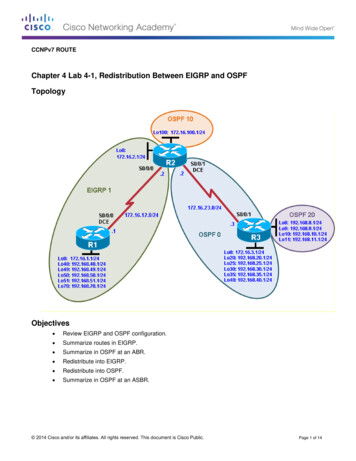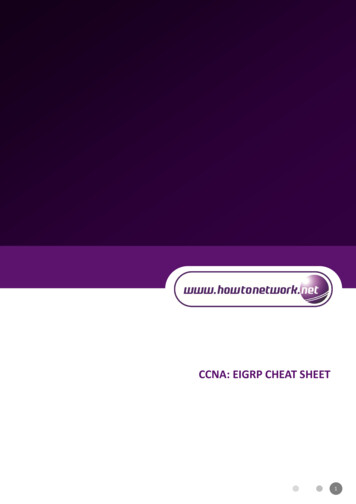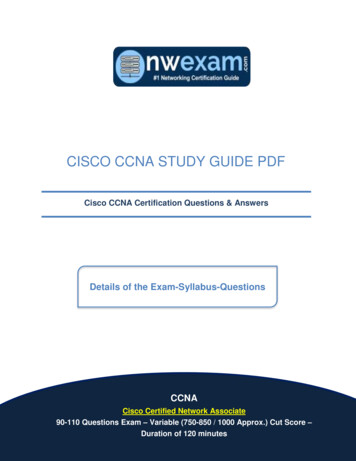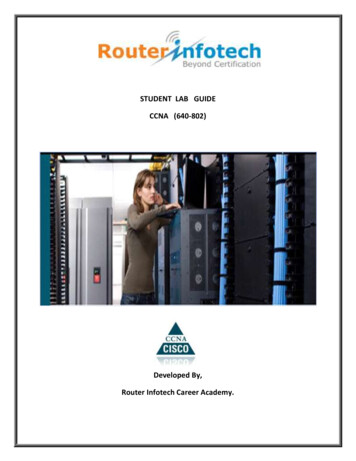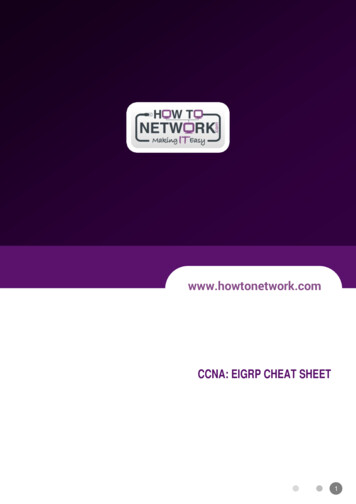
Transcription
www.howtonetwork.comCCNA: EIGRP CHEAT SHEET11
CCNA: EIGRP CHEAT SHEETKey CharacteristicsRouter ID (RID)Type: Advance Distance Vector or HybridAlgorithm: Diffusing Update Algorithm (DUAL)Standard: Cisco ProprietyAdministrative Distance:1. Internal Routes 902. External Routes 1703. Summary Routes 5Metric: CompositeTransport Protocol/Protocol Number: IP/88Routed Protocol Support: IP, IPX and AppleTalkRID should be a valid IP address, not a 32-bit dotteddecimal numberCisco Routers uses the following criteria to select arouter ID:1. RID configured with “router-id” command2. If manual RID not configured, select the highestnumber IP address on any loopback interface in“up/up” state3. If loopback interfaces not configured, select the highestnumber IP address on any non-loopback interface in“up/up” stateRoute Types and PreferenceAuthentication: Yes (MD5 only)Supports VLSM and Route Summarization: YesInternal Routes: routes advertised within the same ASFastest ConvergenceMetric CalculationEIGRP uses a composite metric. Composite metricconsists of bandwidth, load, delay, reliability and MTUBy default, only bandwidth and delay are consideredMetric 256 x [(10 7/minimum-bandwidth) cumulative delay]Bandwidth is in kbps and delay is in micro-secondsMinimum bandwidth represents least bandwidth alongthe entire routeCumulative Delay represents the sum of all delay values for alllinks in the routeNeighbor DiscoveryEIGRP sends hellos on multicast address 224.0.0.10 todiscover potential neighbors. Hellos are always use un- reliabledeliveryTo become neighbors EIGRP routers must be agree onthe following parameters:1. Autonomous System (AS) number2. Same primary subnet3. Authentication (if used)4. K-values must matchExternal Routes: routes imported from another routingdomain or ASInternal Routes are denoted with “D”External Routes are denoted with “EX”Routes Preference:1. Internal Routes (90) External Routes (170)EIGRP Table TypesEIGRPmaintainsthreetypesoftables:1. Neighbor Table: keeps state information regardingneighbors, and is displayed using the “show ip eigrpneighbors” command2. Topology Table: EIGRP Update messages fill the routers’EIGRP topology tables. Topology table can be displayedwith “show ip eigrp topology” command3. (IP) Routing Table: Based on the contents of the topologytable, each router chooses its best routes and installsthese routes in its respective IP routing table. The IProuting table is displayed with “show ip route” commandPacket TypesHello: used in neighbor discovery/recovery process and are always multicast and use unreliable deliveryAcknowledgment: are hello packets without any data and are always unicast & use unreliable deliveryUpdate: Convey route information. Updates are non-periodic, partial, bounded, can be unicast or multicast and use reliable deliveryQuery and Reply: used by DUAL finite state machine. Queries can be unicast or multicast and replies are always unicast. Both queries &replies use reliable deliveryTopology ExchangeEIGRP also exchanges topology updates on multicast address 224.0.0.10. Updates always use reliable delivery.The reliable delivery is ensured using Reliable Transport Protocol (RTP)If an acknowledgment is not received for the multicast update, the update is then re-transmitted as unicast to the un-responsive neighbor.After 16 unicast re-transmission, the neighbor is declared deadEIGRP updates are:1.Non-Periodic: updates are sent only when some topological or metric change has occurred2.Partial: only relevant changes are advertised3.Bounded: updates are sent to affecting neighbors2
CCNA: EIGRP CHEAT SHEETTimersHello Time: 5 seconds for link faster than T1 and 60 seconds for T1 and slower linksHold Time: 3 times the hello. 15 seconds for links faster than T1 and 180 seconds for T1 and slower linksSmooth Round Trip Time (SRTT): the average time elapsed (in milliseconds) between the transmission of packet toneighbor and the receipt of acknowledgeRetransmission Timeout (RTO): time between subsequent unicast messages. It is the time that router will wait for anacknowledgement after sending unicast packet sent after a multicast has failedDUAL Terms and Route SelectionAdjacency: logical session between two neighbors over which route information is exchangedReported Distance (RD): is the distance (metric) towards a destination as advertised by an upstream neighbor.Feasible Distance (FD): Lowest calculated distance (metric) to the destination from local router’s perspective.Some books/texts use Advertised Distance instead of Reported Distance.Successor: A particular route with the best metric is a successor. It may also refer to a router that is being used as thenext-hop for that particular route. With two or more successors (routes) if FDs are the same, load balancing happensautomaticallyFeasible Successor (FS): Backup router with loop-free path for a particular route. FS is a neighbor who’s Reported orAdvertised Distance (AD/RD) is less than the current Feasible Distance (FD) for that particular route. Feasible Successor isone who meets the feasible conditionFeasible Condition (FC): RD of a particular route from a neighbor which is not the current successor for that route mustbe less than the FD for that particular route. The logic is simple: if a neighbors metric for a route is less than mine, then Iknow the neighbor doesn't have a loop going through meEqual and Unequal Cost Load BalancingEIGRP support equal and unequal cost load balancingEqual cost load balancing is enabled by default. Routes with equal feasible distance are installed by default in the routingtableVariance is used to achieve unequal cost load balancing. Default value for variance is: 1, which will cause the EIGRP toselect the best/lowest cost path onlyVariance defines the multiplier by which a metric may differ from the lowest cost route. By default 4-paths are allowedbut can be extended to 16-paths with “maximum-paths path ” commandVariance is given by: higher cost metric / lower cost metricRule for Variance:1.Load balance path should lead to successor or feasible successor (that is it met the Feasibility Condition)Configuration Example: network statement and authentication3
CCNA: EIGRP CHEAT SHEETConfiguration Example: network statement and authenticationRouter R1:Router R2:key chain EIGRP KCkey chain EIGRP KCkey 1key 1key-string ciscokey-string cisco!!interface loopback 0interface loopback 0ip address 10.1.1.1 255.255.255.255ip address 10.2.2.2 255.255.255.255!!interface serial 0/0interface serial 0/0ip address 192.168.12.1 255.255.255.252ip address 192.168.12.2 255.255.255.252ip authentication eigrp 100 md5ip authentication eigrp 100 md5ip authentication key-chain eigrp 100 EIGRP KCip authentication key-chain eigrp 100 EIGRP KC!!router eigrp 100router eigrp 100no autono autosummarysummarynetwork 192.168.12.0network 192.168.12.0network 10.1.1.0network 10.2.2.0R1#sh ip route be GatewayGateway of last resort is not setC192.168.12.0/24 is directly connected, Serial0/010.0.0.0/32 is subnetted, 2 subnetsD10.2.2.2 [90/2297856] via 192.168.12.2, 00:00:13, Serial0/0C10.1.1.1 is directly connected, Loopback0Configuration Example: variance and unequal cost load balancingRouter R1:interface loopback 0ip address 10.1.1.1 255.255.255.255!interface serial 0/0ip address 192.168.12.1 255.255.255.0!interface fastethernet0/0ip address 192.168.21.1 255.255.255.0!router eigrp 100variance 15network 10.1.1.1 0.0.0.0network 192.168.12.1 0.0.0.0network 192.168.21.1 0.0.0.0no auto-summaryRouter R2:interface loopback 0ip address 10.2.2.2 255.255.255.255!interface serial 0/0ip address 192.168.12.2 255.255.255.0!interface fastethernet0/0ip address 192.168.21.2 255.255.255.0!router eigrp 100variance 15network 10.2.2.2 0.0.0.0network 192.168.12.2 0.0.0.0network 192.168.21.2 0.0.0.0no auto-summary4
CCNA: EIGRP CHEAT SHEETR1#sh ip route eigrp10.0.0.0/32 is subnetted, 2 subnetsD10.2.2.2 [90/156160] via 192.168.21.2, 00:03:21, FastEthernet0/0[90/2297856] via 192.168.12.2, 00:03:21, Serial0/0R2#sh ip route eigrp10.0.0.0/32 is subnetted, 2 subnetsD10.1.1.1 [90/156160] via 192.168.21.1, 00:03:06, FastEthernet0/0[90/2297856] via 192.168.12.1, 00:03:06, Serial0/0Troubleshooting Command1.show ip protocols2.show ip eigrp neighbors3.show ip eigrp interfaces4.show ip eigrp topology5.debug eigrp packets [hello ack query reply update]6.debug eigrp fsm5
CCNA: EIGRP CHEAT SHEET Configuration Example: network statement and authentication Router R1: key chain EIGRP_KC key 1 key-string cisco ! interface loopback 0 ip address 10.1.1.1 255.255.255.255 ! interface serial 0/0 ip address 192.168.12.1 255.255.255.252 ip authentication eigrp 100 md5 ip authentication key-chain eigrp 100 EIGRP_KC !
